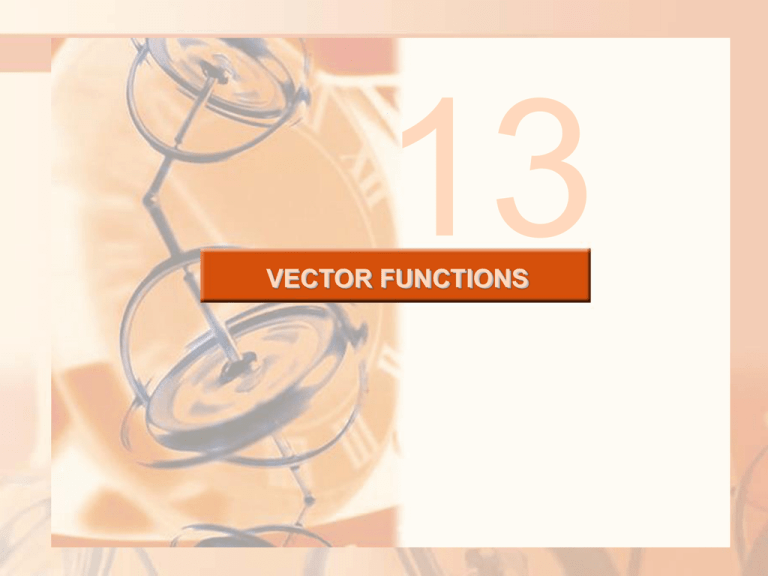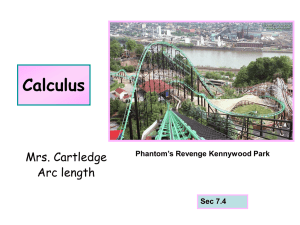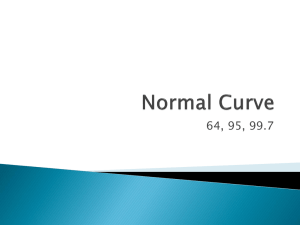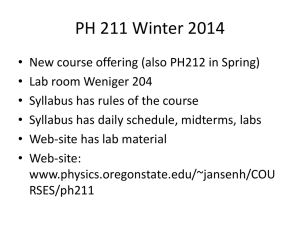Chap13_Sec3
advertisement

13 VECTOR FUNCTIONS VECTOR FUNCTIONS 13.3 Arc Length and Curvature In this section, we will learn how to find: The arc length of a curve and its curvature. PLANE CURVE LENGTH In Section 10.2, we defined the length of a plane curve with parametric equations x = f(t), y = g(t), a≤t≤b as the limit of lengths of inscribed polygons. PLANE CURVE LENGTH Formula 1 For the case where f’ and g’ are continuous, we arrived at the following formula: L b f a '( t ) g '( t ) dt 2 2 b a 2 2 dx dy dt dt dt SPACE CURVE LENGTH The length of a space curve is defined in exactly the same way. SPACE CURVE LENGTH Suppose that the curve has the vector equation r(t) = <f(t), g(t), h(t)>, a≤t≤b Equivalently, it could have the parametric equations x = f(t), y = g(t), z = h(t) where f’, g’ and h’ are continuous. SPACE CURVE LENGTH Formula 2 If the curve is traversed exactly once as t increases from a to b, then it can be shown that its length is: L b f a '( t ) g '( t ) h '( t ) dt 2 2 b a 2 2 2 2 dx dy dz dt dt dt dt ARC LENGTH Formula 3 Notice that both the arc length formulas 1 and 2 can be put into the more compact form L b r '( t ) d t a ARC LENGTH That is because: For plane curves r(t) = f(t) i + g(t) j r '( t ) f '( t ) i g '( t ) j f '( t ) g '( t ) 2 For space curves r(t) = f(t) i + g(t) j + h(t) k r '( t ) f '( t ) i g '( t ) j h '( t ) k f '( t ) g '( t ) h '( t ) 2 2 2 2 ARC LENGTH Example 1 Find the length of the arc of the circular helix with vector equation r(t) = cos t i + sin t j + t k from the point (1, 0, 0) to the point (1, 0, 2π). ARC LENGTH Example 1 Since r’(t) = -sin t i + cos t j + k, we have: r '( t ) ( sin t ) cos t 1 2 2 2 ARC LENGTH Example 1 The arc from (1, 0, 0) to (1, 0, 2π) is described by the parameter interval 0 ≤ t ≤ 2π. So, from Formula 3, we have: L 2 r '( t ) dt 0 2 2 dt 0 2 2 ARC LENGTH A single curve C can be represented by more than one vector function. ARC LENGTH Equations 4 & 5 For instance, the twisted cubic r1(t) = <t, t 2, t 3> 1≤t≤2 could also be represented by the function r2(u) = <eu, e2u, e3u> 0 ≤ u ≤ ln 2 The connection between the parameters t and u is given by t = eu. PARAMETRIZATION We say that Equations 4 and 5 are parametrizations of the curve C. PARAMETRIZATION If we were to use Equation 3 to compute the length of C using Equations 4 and 5, we would get the same answer. In general, it can be shown that, when Equation 3 is used to compute arc length, the answer is independent of the parametrization that is used. ARC LENGTH Now, we suppose that C is a curve given by a vector function r(t) = f(t) i + g(t) j + h(t) k a≤t≤b where: r’ is continuous. C is traversed exactly once as t increases from a to b. ARC LENGTH FUNCTION Equation 6 We define its arc length function s by: s (t ) t r '( u ) du a 2 t a 2 2 dx dy dz du du du du ARC LENGTH FUNCTION Thus, s(t) is the length of the part of C between r(a) and r(t). ARC LENGTH FUNCTION Equation 7 If we differentiate both sides of Equation 6 using Part 1 of the Fundamental Theorem of Calculus (FTC1), we obtain: ds dt r '( t ) PARAMETRIZATION It is often useful to parametrize a curve with respect to arc length. This is because arc length arises naturally from the shape of the curve and does not depend on a particular coordinate system. PARAMETRIZATION If a curve r(t) is already given in terms of a parameter t and s(t) is the arc length function given by Equation 6, then we may be able to solve for t as a function of s: t = t(s) REPARAMETRIZATION Then, the curve can be reparametrized in terms of s by substituting for t: r = r(t(s)) REPARAMETRIZATION Thus, if s = 3 for instance, r(t(3)) is the position vector of the point 3 units of length along the curve from its starting point. REPARAMETRIZATION Example 2 Reparametrize the helix r(t) = cos t i + sin t j + t k with respect to arc length measured from (1, 0, 0) in the direction of increasing t. REPARAMETRIZATION Example 2 The initial point (1, 0, 0) corresponds to the parameter value t = 0. ds From Example 1, we have: r '( t ) dt So, s s (t ) t 0 r '( u ) du t 0 2 du 2t 2 REPARAMETRIZATION Example 2 Therefore, t s / 2 and the required reparametrization is obtained by substituting for t: r ( t ( s )) cos s / 2 i sin s / 2 j s / 2 k SMOOTH PARAMETRIZATION A parametrization r(t) is called smooth on an interval I if: r’ is continuous. r’(t) ≠ 0 on I. SMOOTH CURVE A curve is called smooth if it has a smooth parametrization. A smooth curve has no sharp corners or cusps. When the tangent vector turns, it does so continuously. SMOOTH CURVES If C is a smooth curve defined by the vector function r, recall that the unit tangent vector T(t) is given by: T (t ) r '( t ) r '( t ) This indicates the direction of the curve. SMOOTH CURVES You can see that T(t) changes direction: Very slowly when C is fairly straight. More quickly when C bends or twists more sharply. CURVATURE The curvature of C at a given point is a measure of how quickly the curve changes direction at that point. CURVATURE Specifically, we define it to be the magnitude of the rate of change of the unit tangent vector with respect to arc length. We use arc length so that the curvature will be independent of the parametrization. CURVATURE—DEFINITION Definition 8 The curvature of a curve is: dT ds where T is the unit tangent vector. CURVATURE The curvature is easier to compute if it is expressed in terms of the parameter t instead of s. CURVATURE So, we use the Chain Rule (Theorem 3 in Section 13.2, Formula 6) to write: dT dt d T ds ds dt and dT ds d T / dt ds / dt CURVATURE Equation/Formula 9 However, ds/dt = |r’(t)| from Equation 7. So, (t ) T '( t ) r '( t ) CURVATURE Example 3 Show that the curvature of a circle of radius a is 1/a. We can take the circle to have center the origin. Then, a parametrization is: r(t) = a cos t i + a sin t j CURVATURE Example 3 Therefore, r’(t) = –a sin t i + a cos t j and So, |r’(t)| = a T (t ) r '( t ) sin t i cos t j r '( t ) and T '( t ) cos t i sin t j CURVATURE Example 3 This gives |T’(t)| = 1. So, using Equation 9, we have: (t ) T '( t ) r '( t ) 1 a CURVATURE The result of Example 3 shows—in accordance with our intuition—that: Small circles have large curvature. Large circles have small curvature. CURVATURE We can see directly from the definition of curvature that the curvature of a straight line is always 0—because the tangent vector is constant. CURVATURE Formula 9 can be used in all cases to compute the curvature. Nevertheless, the formula given by the following theorem is often more convenient to apply. CURVATURE Theorem 10 The curvature of the curve given by the vector function r is: (t ) r '( t ) r ''( t ) r '( t ) 3 CURVATURE Proof T = r’/|r’| and |r’| = ds/dt. So, we have: r' r'T ds dt T CURVATURE Proof Hence, the Product Rule (Theorem 3 in Section 13.2, Formula 3) gives: 2 r '' d s dt 2 T ds dt T' CURVATURE Proof Using the fact that T x T = 0 (Example 2 in Section 12.4), we have: ds r ' r '' dt 2 T T ' CURVATURE Proof Now, |T(t)| = 1 for all t. So, T and T’ are orthogonal by Example 4 in Section 13.2 CURVATURE Proof Hence, by Theorem 6 in Section 12.4, 2 ds r ' r '' TT' dt 2 ds T T' dt 2 ds T' dt CURVATURE Proof Thus, T' r ' r '' ds / dt and T' r' 2 r ' r '' r' r ' r '' r' 3 2 CURVATURE Example 4 Find the curvature of the twisted cubic r(t) = <t, t2, t3> at: A general point (0, 0, 0) CURVATURE Example 4 First, we compute the required ingredients: r '( t ) 1, 2 t , 3 t r '( t ) r ''( t ) 0, 2, 6 t 2 1 4t 9t 2 4 CURVATURE Example 4 i j k r '( t ) r ''( t ) 1 2t 3t 0 2 6t 2 6t i 6t j 2 k 2 r '( t ) r ''( t ) 36 t 36 t 4 4 2 2 9t 9t 1 4 2 CURVATURE Example 4 Then, Theorem 10 gives: (t ) r '( t ) r ''( t ) r '( t ) 3 2 1 9t 9t 2 1 4 t 2 9t 4 At the origin, where t = 0, the curvature is: ĸ(0) = 2 4 3/2 CURVATURE For the special case of a plane curve with equation y = f(x), we choose x as the parameter and write: r(x) = x i + f(x) j CURVATURE Then, r’(x) = i + f’(x) j and r’’(x) = f’’(x) j CURVATURE Since i x j = k and j x j = 0, we have: r’(x) x r’’(x) = f’’(x) k CURVATURE We also have: r '( x ) 1 f '( x ) 2 CURVATURE Formula 11 So, by Theorem 10, ( x) f ''( x ) 1 f '( x ) 2 3/2 CURVATURE Example 5 Find the curvature of the parabola y = x2 at the points (0, 0), (1, 1), (2, 4) CURVATURE Example 5 Since y’ = 2x and y’’ = 2, Formula 11 gives: ( x) y '' 1 ( y ') 2 3/2 2 1 4 x 2 3/2 CURVATURE Example 5 At (0, 0), the curvature is κ(0) = 2. At (1, 1), it is κ(1) = 2/53/2 ≈ 0.18 At (2, 4), it is κ(2) = 2/173/2 ≈ 0.03 CURVATURE Example 5 Observe from the expression for κ(x) or the graph of κ here that: κ(x) → 0 as x → ±∞ This corresponds to the fact that the parabola appears to become flatter as x → ±∞ NORMAL AND BINORMAL VECTORS At a given point on a smooth space curve r(t), there are many vectors that are orthogonal to the unit tangent vector T(t). NORMAL VECTORS We single out one by observing that, because |T(t)| = 1 for all t, we have T(t) · T’(t) by Example 4 in Section 13.2. So, T’(t) is orthogonal to T(t). Note that T’(t) is itself not a unit vector. NORMAL VECTOR However, if r’ is also smooth, we can define the principal unit normal vector N(t) (simply unit normal) as: N (t ) T '( t ) T '( t ) NORMAL VECTORS We can think of the normal vector as indicating the direction in which the curve is turning at each point. BINORMAL VECTOR The vector B(t) = T(t) x N(t) is called the binormal vector. BINORMAL VECTORS It is perpendicular to both T and N and is also a unit vector. NORMAL & BINORMAL VECTORS Example 6 Find the unit normal and binormal vectors for the circular helix r(t) = cost i + sin t j + t k NORMAL & BINORMAL VECTORS Example 6 First, we compute the ingredients needed for the unit normal vector: r '( t ) sin t i cos t j k T (t ) r '( t ) r '( t ) 1 2 r '( t ) sin t i cos t j k 2 NORMAL & BINORMAL VECTORS Example 6 T '( t ) 1 2 N (t ) cos t i sin t j T '( t ) cos t i sin t j T '( t ) cos t , sin t , 0 T '( t ) 1 2 NORMAL & BINORMAL VECTORS Example 6 This shows that the normal vector at a point on the helix is horizontal and points toward the z-axis. NORMAL & BINORMAL VECTORS Example 6 The binormal vector is: i 1 B (t ) T (t ) N (t ) sin t 2 cos t 1 2 j cos t sin t sin t , cos t ,1 k 1 0 NORMAL & BINORMAL VECTORS The figure illustrates Example 6 by showing the vectors T, N, and B at two locations on the helix. TNB FRAME In general, the vectors T, N, and B, starting at the various points on a curve, form a set of orthogonal vectors—called the TNB frame—that moves along the curve as t varies. TNB FRAME This TNB frame plays an important role in: The branch of mathematics known as differential geometry. Its applications to the motion of spacecraft. NORMAL PLANE The plane determined by the normal and binormal vectors N and B at a point P on a curve C is called the normal plane of C at P. It consists of all lines that are orthogonal to the tangent vector T. OSCULATING PLANE The plane determined by the vectors T and N is called the osculating plane of C at P. The name comes from the Latin osculum, meaning ‘kiss.’ OSCULATING PLANE It is the plane that comes closest to containing the part of the curve near P. For a plane curve, the osculating plane is simply the plane that contains the curve. OSCULATING CIRCLE The osculating circle (the circle of curvature) of C at P is the circle that: Lies in the osculating plane of C at P. Has the same tangent as C at P. Lies on the concave side of C (toward which N points). Has radius ρ = 1/ĸ (the reciprocal of the curvature). OSCULATING CIRCLE It is the circle that best describes how C behaves near P. It shares the same tangent, normal, and curvature at P. NORMAL & OSCULATING PLANES Example 7 Find the equations of the normal plane and osculating plane of the helix in Example 6 at the point P(0, 1, π/2) NORMAL & OSCULATING PLANES Example 7 The normal plane at P has normal vector r’(π/2) = <–1, 0, 1>. So, an equation is: 1 x 0 0 y 1 1 z 0 2 or z x 2 NORMAL & OSCULATING PLANES Example 7 The osculating plane at P contains the vectors T and N. So, its normal vector is: TxN=B NORMAL & OSCULATING PLANES Example 7 From Example 6, we have: B (t ) 1 sin t , cos t ,1 2 B 2 1 2 , 0, 1 2 NORMAL & OSCULATING PLANES Example 7 A simpler normal vector is <1, 0, 1>. So, an equation of the osculating plane is: 1 x 0 0 y 1 1 z 0 2 or z x 2 NORMAL & OSCULATING PLANES The figure shows the helix and the osculating plane in Example 7. OSCULATING CIRCLES Example 8 Find and graph the osculating circle of the parabola y = x2 at the origin. From Example 5, the curvature of the parabola at the origin is ĸ(0) = 2. So, the radius of the osculating circle at the origin is 1/ĸ = ½ and its center is (0, ½). OSCULATING CIRCLES Example 8 Therefore, its equation is: x y 2 1 2 2 1 4 OSCULATING CIRCLES Example 8 For the graph, we use parametric equations of this circle: x = ½ cos t y = ½ + ½ sin t OSCULATING CIRCLES Example 8 The graph is displayed. SUMMARY We summarize the formulas for unit tangent, unit normal and binormal vectors, and curvature. T (t ) r '( t ) N (t ) r '( t ) T '( t ) B (t ) T (t ) N (t ) T '( t ) dT ds T '( t ) r '( t ) r '( t ) r ''( t ) r '( t ) 3






